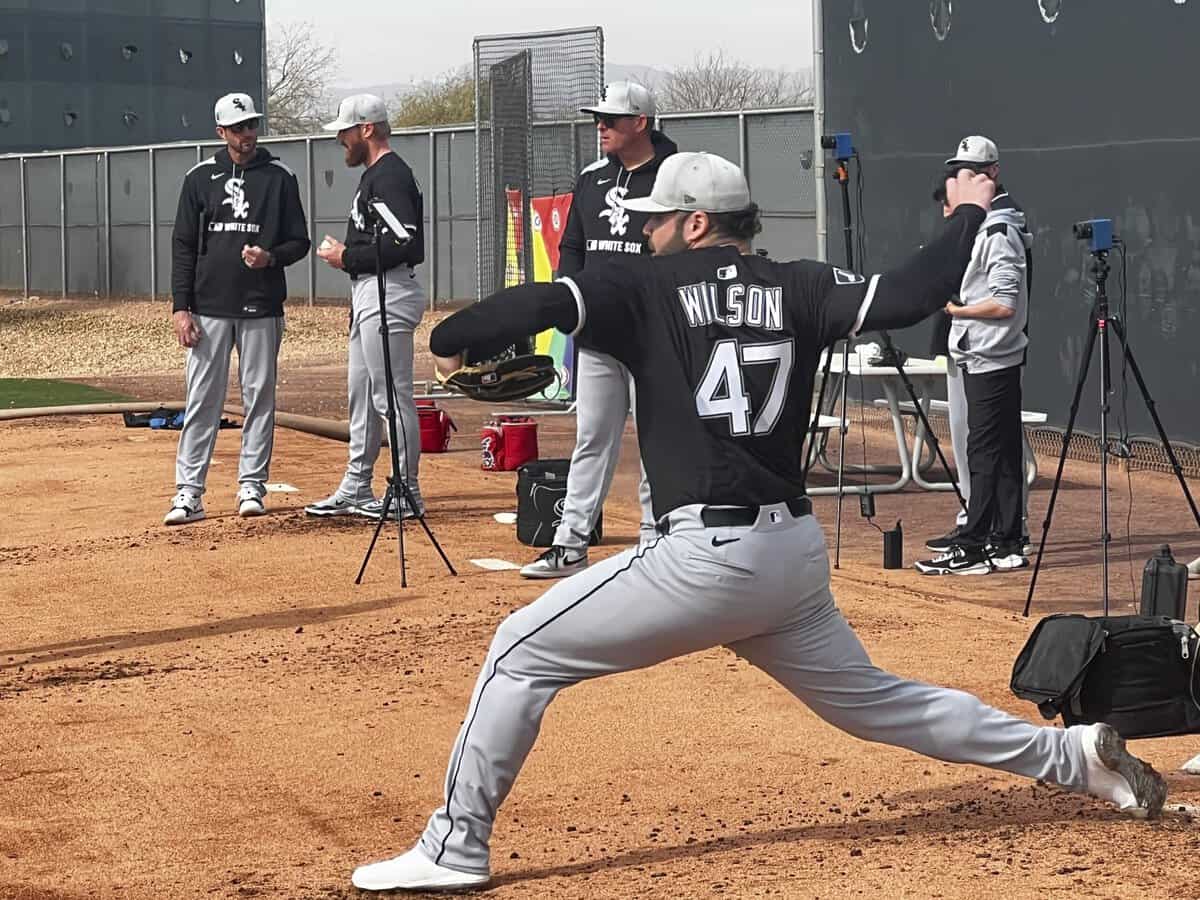Strike-throwing and weak contact has helped keep Bryse Wilson's surface-level numbers intact so far (4.50 ERA in 12 innings), but it would be hard to miss the four home runs (all of them barreled) that have spiked all his run estimators much farther north (6.38 xERA, 6.79 FIP) as he prepares to shift back to starting in the wake of Martín Pérez's flexor muscle injury.
All that damage has come against Wilson's curveball and cutter, which were crucial pitches for him -- especially against left-handers -- over the past few years as he transitioned away from depending on the four-seam/slider combo that once made him a top-100 prospect. With the White Sox, Wilson has lowered his arm slot to give all his pitches more of an east-west orientation. As a result, the changing movement profiles of these breaking balls are just one more thing Wilson has been adjusting to, along with sitting more 91-92 mph than 93-94 mph in the early going, and more single-inning work than the multi-inning/spot starter role he filled in Milwaukee.


"I'm super happy with [the arm slot change]," Wilson said. "The stuff has been there. The command has been a little bit off with the off speed but there was a little mechanical issue that we made the adjustment with. Hopefully I can command those better because the stuff is better, the numbers on them is really, really good. It's just throwing those competitively in the strike zone."
The spike in changeup use is most directly related to the drop in slot, as Wilson has been able to take more velocity off the pitch and generate more arm-side movement and sink than ever before. Even if he hasn't had the cleanest separation with it from his sinker, those two pitches currently stick out from his arsenal for what hitters have not been able to drive or lift, as the Statcast expected slugging percentage against each offering is under .300. The slot adjustment dates back to Wilson's work with bench coach Walker McKinven at the tail end of last year in Milwaukee.
"He's kind of young, he's entering his age-27 season so I think his best baseball is still in front of him," McKinven said. "He's done every single role in the past two years. He's finished off games. He's thrown mop-up innings. He's thrown length out of the bullpen, he's thrown one inning out of the bullpen as a righty specialist and he's started games for an extended period of time. So he's just a really, really valuable pitcher to have on your staff. Great person and a really, really talented pitcher."
With how little Wilson has been able work in extended stretches -- both due to team need and recent performance -- it would be surprising if he's able to offer significantly more than three innings, which is a length he more or less feels like he can always provide at a moment's notice. But Wilson's sinker and change currently look like the pitches most able to get him there efficiently.
⚙️⚙️⚙️
Through 21 games, the strikeout-to-walk ratio (20 K, 4 BB) and especially the chase rate (38.6 percent) for Andrew Vaughn are actually a measure worse than his career norms, but his batted ball numbers continue to stave off any outward panic about his ugly .145/.184/.277 line. It certainly has kept Vaughn up in the middle of the White Sox order.
"Just hitting the ball hard, that's our goal every time we go up there," Vaughn said. "Obviously there's some things like limiting swinging at bad pitches. But you've got to take the good with the bad. If you're hitting the ball hard, you can't get down on yourself."
"There’s been a lot of balls that have been hit that, if it’s not cold or windy, I think Vaughn should have about six, seven homers," said Andrew Benintendi.
Too much contact is going into the ground (46 percent), but Vaughn's barrel (15.9 percent) and hard-hit rates (49.2 percent) tracking at career-high levels in the early going are getting specifically cited for why his second straight slow start doesn't draw the same concern as last year's season-opening slump. That one ultimately prompted some slight mechanical tweaks to make Vaughn more viable against fastballs.
"He wasn't hitting balls hard [in early 2024], and that's the key for me, and that's what I told him," said hitting coach Marcus Thames. "Keep hitting balls hard and try to flush last year. You don't want to think about that. I know the real numbers don't look look great, but there's some underlying stuff that we look at that let us know he's close to where he needs to be."
Thames referenced the gulf between Vaughn's expected numbers and current results, and the most glaring example is Statcast projecting him for a .540 slugging percentage against fastballs, versus his actual .238 mark over 33 batted ball events. That gap is pretty absurd and surely can't persist, but also 2023 is the only year Vaughn's actual slugging percentage against heaters wasn't at least 50 points lower than his Statcast projection.
Vaughn's xSLG on fastballs has been north of .500 ever year of his big league career. If those projections and his reality regularly aligned, he might be looked at differently.
⚙️⚙️⚙️
Wilson's sinker and changeup pairing has produced good results so far, but looking at his 2025 Statcast pitch movement plot, they run together a bit. A hitter sitting sinker could conceivably foul off a changeup (or worse, pull it into the White Sox bullpen), and that's something he'll inevitably keep working to clean up.
Hopefully at some point, it would look something like this.

Don't kick yourself if you didn't immediately guess who this is, because Cam Booser has only pitched nine games in a White Sox uniform. He gave up a pair of solo shots early in his tenure (one was harmless, one lost a game), but they remain the only runs he's allowed in nine innings this year while striking out 11, backing up the org's early belief that the soon-to-be 33-year-old can be trusted as one of their top leverage arms.
"It bridges that velocity gap where they don't just see a fastball or wait on a breaking ball, they have to look for another pitch," Booser said. "We use [the cutter] more to righties, but we're starting to open it up to lefties a little bit more, too."
Booser's cutter splits the difference between his sweeper and four-seamer, both in the sense of a velocity middle point and also that they all look like separate points on the same straight line. After such a ramshackle path to the majors, delayed by countless injuries, multiple stops at both the collegiate and professional level and even some independent ball days with the Chicago Dogs, Booser didn't arrive with such a polished array of offerings all on the same axis on accident.
"The cutter actually started with my old trainer by the name of Kyle Rogers, he works with the Mets now," Booser said. "When I was coming out of retirement, I had a really bad slurve, like 78 mph. His thought was we needed something in the middle ground to bridge the velocity gap. He was the one to introduce it to me. And then a buddy of mine Garrett Westberg back home in Washington, he was the one who helped me refine it. Over the years I kind of got more comfortable with it. The sweeper came pretty much last year with the Red Sox, they helped me re-define that pitch and then it's been consistent work with it ever since."






